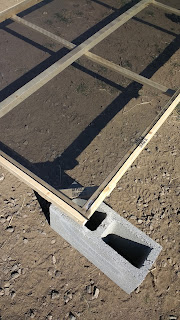why dehydrating? Several reasons:
1. It is fairly quick and cheap if the sun is the power source
2. It can scale easily
3. It preserves sugar (where fermenting converts sugar into acid)
4. It separates juice from bulk, so both can be utilized
The overall plan is simple... the extra produce goes into our chipper/shredder to pulverize it and separate the liquid juices from the bulk. the juice is captured and stored in buckets to freeze. The bulk is placed on drying racks for a few days and then bagged for storage.
Today we built an initial drying rack to test the design. The cost per rack with this method is around $12 for a 4' x 8' rack covered in standard fiberglass window screen. 2x2 and 1x2 pine form the frame to make it sturdy but light.
Here are some closeup pics of version 1:
 |
| The finished screen, version 1. |
 |
| Closeup of the design |
 |
| Standard 45 corner braces |
 |
| I cut a slot to accommodate the standard spline to hold window screen. this might need to be reinforced. |
 |
| Here it is in the garden, on blocks and ready for use! |
The Chipper / Shredder is a large PTO driven model with a wide screen. I would like an even wider screen to make larger chunks, but too expensive to warrant buying one. Some adjustment of the exit door should make things flow nicely.
We placed the chipper / shredder into a kiddie pool, so that the juice is caught and can be easily removed to store in buckets separately. When we do pears, there will be a LOT of juice.
the produce is slipped into the branch chute, not he brush entry at the top. This makes larger chunks with less shredding.
 |
| The finished working setup, a tarp underneath keeps the dead grass down and out of the way. |
 |
| And here is the finished product.. a tray full of dripping pulp and chunks, drying in the sun. |











































